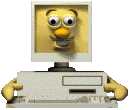|
We have seen how the double
arrows (<<) of the cout
show that the information is going "out" to the monitor. In a similar
way, the double arrows (>>) of the
cin (pronounced
see-in) show characters flowing "into" the
program. The arrows point the way.
When using cin, it is
always necessary to provide a variable to the right of the operator to receive the input. |
 |
Sample program:
// sample program for cin
#include <iostream.h>
int main(void)
{
int fleas;
cout << "How many fleas does your cat have?";
cin >> fleas;
cout << "Well, that's " << fleas << " fleas too many!! \n\n\n";
return 0;
}
cin
can accept more than one variable as follows:
cout << "Enter an integer and a decimal:";
cin >> integer >> decimal;
You would enter the values by typing on a single line and leaving a space between them, or by typing them on separate lines and hitting ENTER after each entry.
|